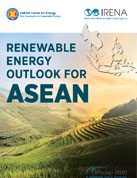Renewable energy outlook for ASEAN
 The nations of Southeast Asia stand at a crossroads in terms of their collective energy future. Amid rapid economic growth, they face a 50% rise in regional energy demand within a decade. This brings challenges in supplying energy affordably, sustainably and securely. Recognising this, the Association of Southeast Asian Nations (ASEAN) aims to rely more on renewables to support a sustainable, secure and prosperous future. The region has set out to make 23% of its primary energy renewable by 2025, compared to 9.4% in 2014. Yet current policies -- including those still under consideration – only suffice to reach just under 17% renewables. This leaves a crucial six-percentage-point gap. The International Renewable Energy Agency (IRENA) has worked intensively with the ASEAN Centre for Energy and ASEAN’s ten member states to find ways to accelerate renewable energy deployment in line with the region’s goal. As this report indicates, that goal is achievable. Moreover, increased reliance on renewables would bring lower overall costs, cleaner cities, and a more secure and robust energy supply. The report – part of IRENA’s global REmap analysis – goes into depth on the technologies required for this ambitious transition. While renewable power technologies are vital, significant scale-up is also needed in renewable heating, cooking and transport.
The nations of Southeast Asia stand at a crossroads in terms of their collective energy future. Amid rapid economic growth, they face a 50% rise in regional energy demand within a decade. This brings challenges in supplying energy affordably, sustainably and securely. Recognising this, the Association of Southeast Asian Nations (ASEAN) aims to rely more on renewables to support a sustainable, secure and prosperous future. The region has set out to make 23% of its primary energy renewable by 2025, compared to 9.4% in 2014. Yet current policies -- including those still under consideration – only suffice to reach just under 17% renewables. This leaves a crucial six-percentage-point gap. The International Renewable Energy Agency (IRENA) has worked intensively with the ASEAN Centre for Energy and ASEAN’s ten member states to find ways to accelerate renewable energy deployment in line with the region’s goal. As this report indicates, that goal is achievable. Moreover, increased reliance on renewables would bring lower overall costs, cleaner cities, and a more secure and robust energy supply. The report – part of IRENA’s global REmap analysis – goes into depth on the technologies required for this ambitious transition. While renewable power technologies are vital, significant scale-up is also needed in renewable heating, cooking and transport.
